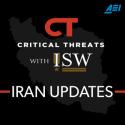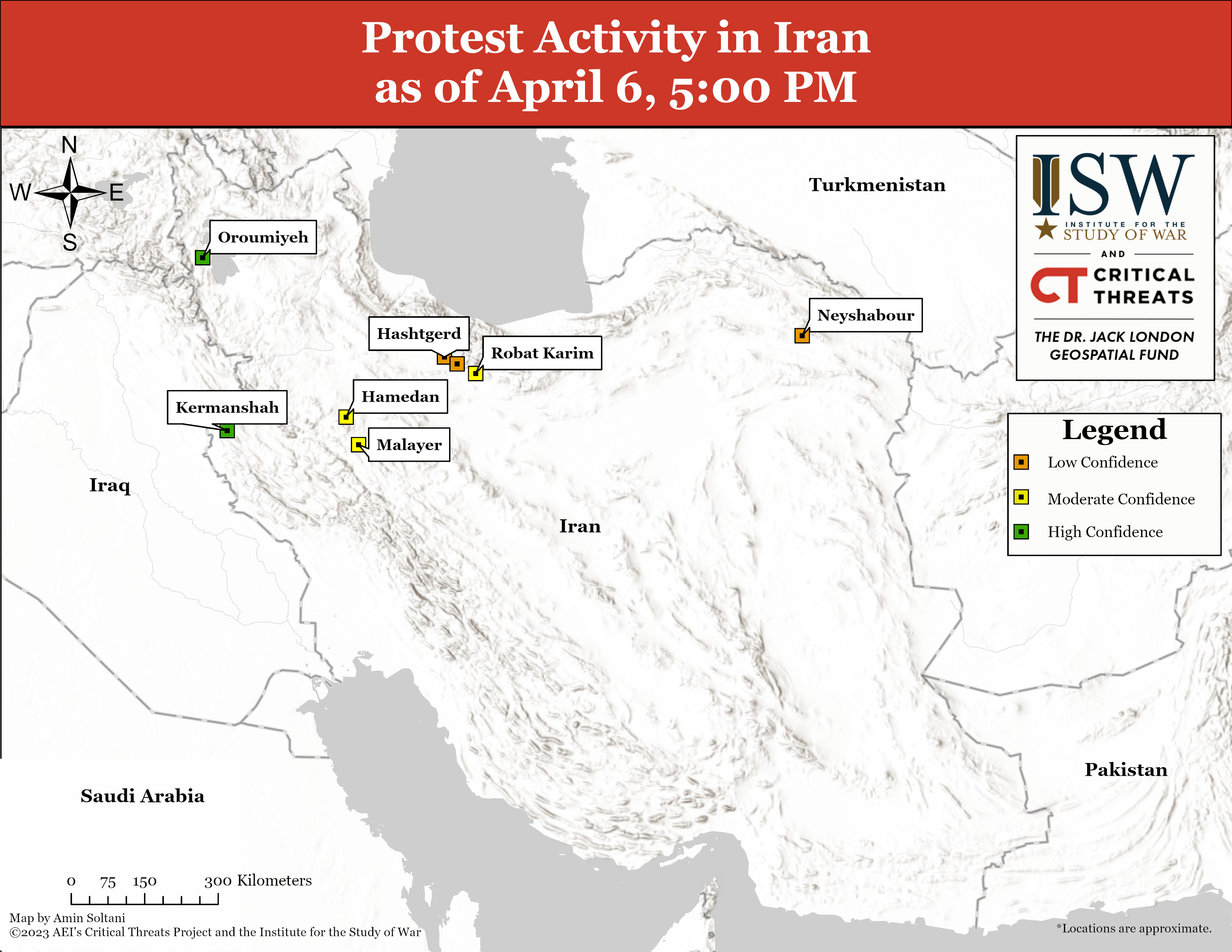 |
 |
Iran Update, April 6, 2023

Iran Update, April 6, 2023
Zachary Coles, Amin Soltani, Annika Ganzeveld, and Nicholas Carl
April 6, 2023, 5:00 pm ET
The Iran Updates are produced by the Critical Threats Project (CTP) at the American Enterprise Institute with support from the Institute for the Study of War (ISW). To receive Iran Updates via email, please subscribe here.
Hamas conducted a large-scale rocket attack from southern Lebanon into Israel on April 6 possibly as part of the larger pattern of escalation between Iran and Israel occurring throughout 2023. Hamas and other unidentified Palestinian militants launched at least 34 rockets into northern Israel, with four landing in Israeli territory and injuring at least three people.[1] Israeli forces intercepted around 25 rockets, and several more fell short of the border. Hamas launched an additional two rockets into Israel several hours later. Hamas spokesperson Hazem Qassem framed the attacks as retaliation for Israeli raids and mass arrests inside the Al Aqsa Mosque in Jerusalem on April 4-5.[2] Palestinian Islamic Jihad militants launched as many as 15 rockets from the Hamas-controlled Gaza Strip on April 5 in response to the raids, as CTP previously reported.[3]
Lebanese Hezbollah (LH) likely had advance knowledge of the attacks and may have even greenlighted it. Hamas Political Bureau Chairman Ismail Haniyeh traveled to Lebanon on April 5, as CTP previously reported, visiting Beirut and southern Lebanon.[4] Haniyeh reportedly met with senior LH officials, such Hassan Nasrallah, and Hamas militants during the visits, possibly to discuss and prepare for the attacks.[5] The fact that Hamas was able to conduct a second rocket attack several hours after the first one without LH intervening to prevent it further indicates that LH may have been complicit in the operation. Iranian leaders would have been presumably aware of the planned attacks as well if Hamas did, in fact, coordinate with Nasrallah.
Iran and LH may have encouraged or tacitly approved the rocket attacks in retaliation for a series of Israeli airstrikes in Syria in recent weeks. Israel conducted airstrikes around Damascus on March 30, killing two IRGC officers.[6] Iranian leaders have acknowledged that Israel killed these officers and have vowed publicly in recent days to retaliate, as CTP previously reported.[7] Iranian leaders could portray the attacks as at least part of their retaliation regardless of whether they had any meaningful role in the planning and execution of the operation.
If Iran and LH were, in fact, involved in the attack, it signifies them expanding the geographic scope of their escalation pattern with Israel. The ongoing cycle of violence between Tehran and Tel Aviv has occurred primarily in Syria throughout 2023 thus far. Tehran may be expanding the geographic scope of the conflict to deter further Israeli action against Iranian interests in Syria. Involving Lebanon and Palestine in the escalation cycle threatens Israel with spreading the conflict further to involve additional crises. Conducting the rocket attacks from Lebanon has the added effect of raising the cost of certain Israeli responses given that retaliatory airstrikes into Lebanon would risk triggering an intensifying conflict with Lebanese Hezbollah and the Palestinian militant groups.
Key Takeaways
- Hamas conducted a large-scale rocket attack from southern Lebanon into Israel on April 6 likely as part of a larger pattern of escalation between Iran and Israel occurring throughout 2023.
- At least eight protests occurred in eight cities across six provinces.
- Iranian security leaders continued emphasizing the internal security threat that they face in Sistan and Baluchistan Province.
- Iranian officials continue to frame the mandatory hijab law as a popular demand.
Internal Security and Protest Activity
At least eight protests occurred in eight cities across six provinces on April 6. CTP assesses with moderate to high confidence that protests occurred in the following locations:
Oroumiyeh, West Azerbaijan Province[8]
- Size: Small
- Demographic: Teachers
Kermanshah City, Kermanshah Province[9]
- Size: Small
- Demographic: Teachers
- Notes: Protesting the arrest of teachers union activist Mohammad Habibi[10]
Robat Karim, Tehran Province[11]
- Size: Small
- Demographic: Teachers
Hamedan City, Hamedan Province[12]
- Size: Small
- Demographic: Teachers
Malayer, Hamedan Province[13]
- Size: Small
- Demographic: Teachers
CTP assesses with low confidence that protests occurred in the following locations:
Hashtgerd, Alborz Province[14]
- Size: Small
- Demographic: Savojbolagh Governate employees
Neyshabour, Khorasan Razavi Province[15]
- Size: Small
- Demographic: Teachers
Karaj, Alborz Province[16]
- Size: Small
- Demographic: Teachers
Supreme Leader Ali Khamenei invoked Persian nationalism during a meeting with Iranian poets and Persian literature teachers on April 5. Khamenei emphasized the importance of ancient Persian poets, such as Ferdowsi, Saadi, and Hafez, in Iranian history.[17] Khamenei separately compared the Mongols who attacked Persia centuries ago to the Islamic Republic’s Western enemies, trying to emphasize a line of continuity from ancient Persia to the Islamic Republic. The supreme leader’s website additionally used the term Parsi—instead of Farsi—for the world “Persian.”[18] Parsi and Farsi both mean “Persian,” but the former is written with the Persian letter ‘p’ which does not exist in Arabic and is thus considered a more traditional Persian representation of the word. Khamenei has previously incorporated Persian nationalist rhetoric into his statements, but his use of such rhetoric in his April 5 speech is noteworthy given recent regime efforts to convince the population that the national Iranian identity is inextricably interwoven with the regime’s religious ideology.[19] President Ebrahim Raisi previously discussed “reviving the national Iranian-Islamic identity” during a meeting with the Board of Trustees of the Iranology Foundation on March 16.[20] Numerous regime officials have separately emphasized the compatibility of Nowrouz—the Persian New Year with Zoroastrian origins—and Ramadan—one of the most important holidays in Islam—in recent weeks, as CTP previously reported.[21]
Iranian security leaders continued emphasizing the internal security threat that they face in Sistan and Baluchistan Province on April 6. Law Enforcement Deputy Commander Brigadier General Ghassem Rezaei warned that anti-regime groups seek to undermine stability in the province during a meeting with police officials in Iranshahr, Sistan and Baluchistan Province.[22] Rezaei added that the Law Enforcement Command will increase patrols throughout the province. IRGC Ground Forces Commander Brigadier General Mohammad Pak Pour similarly warned that foreign-backed actors are trying to destabilize the province on March 28, as CTP previously reported.[23] These security leaders are likely responding to the large-scale protests led by prominent Sunni cleric Moulana Abdol Hamid in Zahedan every Friday.
Iranian officials continue to frame the mandatory hijab law as a popular demand. Culture and Islamic Guidance Minister Mohammad Mehdi Esmaili stated on April 6 that 80 percent of Iranian women support wearing the hijab.[24] Esmaili added that citizens have a greater desire to “preserve values” now than they did at the start of the Mahsa Amini protest movement in September 2022. Judiciary Chief Gholam Hossein Mohseni Ejei separately stated on April 6 that the vast majority of Iranians are religious but that even those who do not hold strong religious beliefs “still have honor.”[25] President Ebrahim Raisi previously stated on April 3 that most women and girls adhere to the hijab law and that observance of the hijab is a “common” demand, as CTP previously reported.[26] Regime officials have additionally doubled down on efforts to coopt pro-regime loyalists to enforce mandatory veiling in recent days. The regime will likely frame some private citizens’ enforcement of the mandatory hijab law as evidence that the regime’s desire to create a “chaste” society is shared by the public at large.
Economic Affairs
The Iranian rial appreciated from 511,500 rials to one US dollar on April 5 to 507,000 rials to one US dollar on April 6.[27]
Senior regime officials continue to reiterate their commitment to pursuing Supreme Leader Ali Khamenei’s economic slogan for the new year of “control inflation and increase production.” First Vice President Mohammad Mokhber presided over a meeting organized around the theme of “activating the private sector to grow production and control inflation” on April 6.[28] He stated that the economic problems of the country will not be solved without the active participation and support of the private sector. Judiciary Chief Gholam Hossein Mohseni Ejei similarly stated on April 6 that resolving Iran’s economic issues is the key to addressing the rest of the country’s problems and called Khamenei’s new year slogan a “beacon” for the country.[29] Other senior regime officials have expressed similar sentiments on April 5, as CTP previously reported.[30] President Ebrahim Raisi expressed support for a vague idea of privatization and called for controlling inflation and increasing production during a joint meeting between administration officials and parliamentarians.[31] Parliament Speaker Mohammad Bagher Ghalibaf called for the “popularization of the economy” during the same meeting.[32] Ghalibaf has become a key advocate for minimizing the roles of state and parastatal institutions in the economy, as CTP previously reported.[33]
Foreign Policy and Diplomacy
Foreign Affairs Minister Hossein Amir Abdollahian met with his Saudi counterpart Faisal bin Farhan in Beijing on April 6 to coordinate resuming diplomatic relations.[34] The two ministers discussed reimplementing their 2001 security cooperation agreement, expanding economic cooperation, resuming intercountry flights, reopening their embassies and consulates, and generally pursuing security and economic prosperity throughout the region. Iran and Saudi Arabia reestablished bilateral relations on March 10 after severing diplomatic ties in 2016, as CTP previously reported.[35] Supreme National Security Council Secretary Ali Shamkhani signed a tripartite agreement with Saudi National Security Advisor Musaid bin Mohammad al Aiban and senior Chinese diplomat Wang Yi in Beijing on the same day.[36]
The Azerbaijani Foreign Affairs Ministry expelled four Iranian embassy employees from Azerbaijan on April 6. The ministry described these employees as “persona non grata” and condemned Iran’s “recent provocative actions against Azerbaijan.”[37] Azerbaijani authorities separately arrested six individuals accused of working with Iran’s security services to overthrow the Azerbaijani government and install a religious regime on April 6.[38] Iran’s deteriorating relations with Azerbaijan coincide with the strengthening of Israeli-Azerbaijani ties in recent weeks. 210 Iranian parliamentarians issued a statement on April 5 warning Azerbaijan that it will face “negative political consequences” for opening an embassy in Tel Aviv.[39] Foreign Affairs Ministry Spokesperson Nasser Kanani separately warned that Iran will not remain indifferent to improved Israeli-Azerbaijani relations on March 31, as CTP previously reported.[40] Iranian officials have repeatedly claimed that Israeli intelligence services use Azerbaijan to organize and support covert operations in Iran.[41]
[1] https://www.aljazeera dot com/news/2023/4/6/israel-intercepts-rocket-fired-from-southern-lebanon-military
[2] https://twitter.com/AlMayadeenNews/status/1644095487518154753?s=20
[3] https://www.criticalthreats.org/analysis/iran-update-april-5-2023
[4] https://www.criticalthreats.org/analysis/iran-update-april-5-2023; https://twitter.com/IsraelMFA/status/1644011693666709504?t=QHra9GvzMkP3MR_2Qc0GmQ&s=19
[5] https://hamas dot ps/ar/p/17070; https://t.me/hamasps/14736; https://twitter.com/IntelDoge/status/1644052765163900953?s=20
[6] https://www.criticalthreats.org/analysis/iran-update-april-3-2023; https://www.criticalthreats.org/analysis/iran-update-march-31-2023
[7] https://www.criticalthreats.org/analysis/iran-update-april-4-2023
[8] https://twitter.com/hra_news/status/1643998519693303811?cxt=HHwWhoCzmbD809AtAAAA;
https://twitter.com/RadioFarda_/status/1643989997358583809?cxt=HHwWgsDU7aeM0NAtAAAA;
https://twitter.com/iranworkers/status/1643978717377728523?cxt=HHwWlsDQud37ytAtAAAA
[9] https://twitter.com/iranworkers/status/1643941243594964992?cxt=HHwWgIC8gbz2udAtAAAA;
https://twitter.com/iranworkers/status/1643888220348850176?cxt=HHwWgIC9hY7oodAtAAAA;
https://twitter.com/hra_news/status/1643941321529257986?cxt=HHwWhMCz1YD7udAtAAAA;
https://twitter.com/hra_news/status/1643916979034632192?cxt=HHwWgMC9-YryrtAtAAAA;
https://twitter.com/RadioFarda_/status/1643987271560073218?cxt=HHwWhMDQidPtztAtAAAA
[10] https://www dot en-hrana dot org/teachers-union-activist-mohammad-habibi-arrested/
[11] https://twitter.com/iranworkers/status/1643934944626982918?cxt=HHwWjIC-hemHt9AtAAAA;
https://twitter.com/RadioFarda_/status/1643987933630967810?cxt=HHwWhMDR8ZeUz9AtAAAA
[12] https://twitter.com/iranworkers/status/1643925825610301441?cxt=HHwWgoC-iYP1stAtAAAA;
https://twitter.com/hra_news/status/1643921541221031936?cxt=HHwWgIC98dH7sNAtAAAA
[13] https://twitter.com/iranworkers/status/1643924789185110016?cxt=HHwWgICzjdm4stAtAAAA;
https://twitter.com/hra_news/status/1643921541221031936?cxt=HHwWgIC98dH7sNAtAAAA
[14] https://twitter.com/iranworkers/status/1643927642465239040?cxt=HHwWgICw2ePes9AtAAAA
[15] https://twitter.com/iranworkers/status/1643925096833114112?cxt=HHwWgICzoc3KstAtAAAA
[16] https://twitter.com/iranworkers/status/1643888113884835840?cxt=HHwWgMC96fThodAtAAAA
[17] https://www.leader dot ir/fa/content/26412
[18] https://www.leader dot ir/fa/content/26412
[19] https://www.criticalthreats.org/analysis/iran-update-march-16-2023
[20] http://www.president dot ir/fa/143007
[21] https://www.criticalthreats.org/analysis/iran-update-march-16-2023
[22] dot ir/news/85075400; https://www.tasnimnews dot com/fa/news/1402/01/17/2876198
[23] https://www.criticalthreats.org/analysis/iran-update-march-28-2023
[24] https://www.entekhab dot ir/fa/news/721452
[25] https://www.farsnews dot ir/alborz/news/14020117000415;
https://www.mizanonline dot ir/fa/news/4706307
[26] https://www.criticalthreats.org/analysis/iran-update-april-3-2023
[27] https://bonbast dot com
[28] https://www.isna dot ir/news/1402011707757
[29] https://www.mizanonline dot ir/fa/news/4706307; https://www.farsnews dot ir/alborz/news/14020117000415
[30] https://www.criticalthreats.org/analysis/iran-update-april-5-2023
[31] http://www.president dot ir/fa/143187
[32] https://www.entekhab dot ir/fa/news/721418
[33] https://www.criticalthreats.org/analysis/iran-update-february-27-2023; https://www.criticalthreats.org/analysis/iran-update-march-23-2023
[34] https://www.irna dot ir/news/85075372; https://mfa dot ir/portal/NewsView/716422; https://www.irna dot ir/news/85075153
[35] https://www.criticalthreats.org/analysis/iran-update-march-10-2023
[36] https://www.criticalthreats.org/analysis/iran-update-march-10-2023
[37] https://www.isna dot ir/news/1402011707741
[38] https://www.bloomberg.com/news/articles/2023-04-06/azerbaijan-arrests-group-accused-of-plotting-iran-backed-coup#xj4y7vzkg
[39] https://www.understandingwar.org/backgrounder/iran-update-april-5-2023
[40] https://www.criticalthreats.org/analysis/iran-update-march-31-2023
[41] https://www.criticalthreats.org/analysis/iran-crisis-update-january-31-2023

